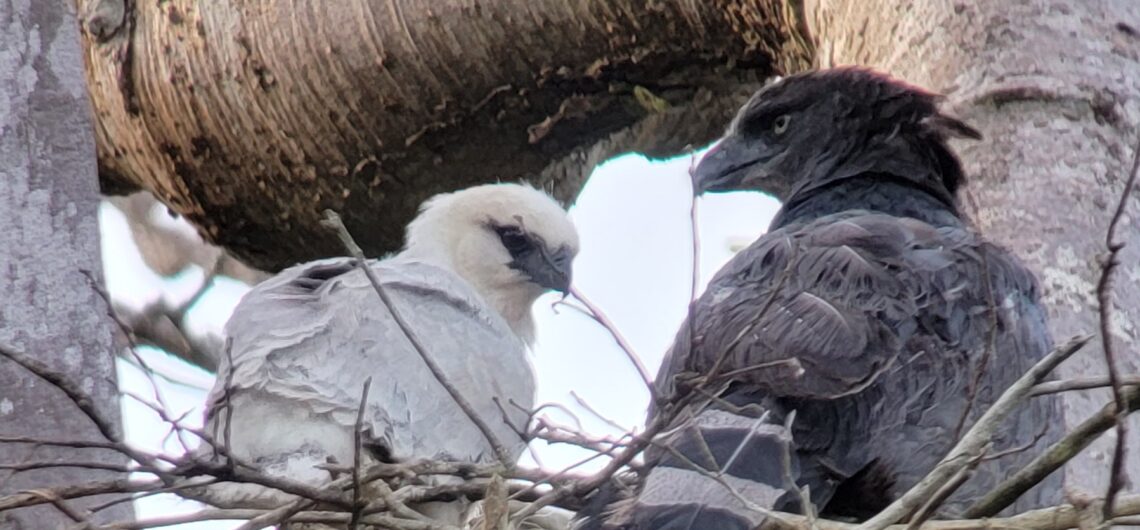A look at Life in the Lowland Rainforest
By Alexandra Eastman
I was raised on jungle stories that my father would tell me before bed of his time spent in Panama before I was born: walking through dense vegetation with tarantulas clinging to his backpack, narrowly avoiding stepping on a huge Bushmaster snake, hearing the sound of vampire bats landing next to him as he lay in his sleeping bag on the forest floor. I imagined a wilderness wholly different from the environment where I grew up in upstate New York. Many might hear these stories and be deterred from ever visiting such a place, but there are some who become captivated hearing such tales. I was one of those people and I suspect most of those reading this are as well.
When I learned I would be going to the wildest part of this wild place, the Darién—during the rainy season no less—I expected the worst. I prepared to not be able to touch the trees, to have to do my research in continuous rain, to be bitten and assaulted by insects yet to be described by science. Well…. yes and no…. but surprisingly mostly no. Yes, there were trees with trunks covered in 3-inch-long spines, but they were very obvious and easily avoidable. I can’t say the same for the poison ivy I would always suffer from at least once per summer at home. Yes, some days there were downpours that were so strong my view of the eagle nest was completely obstructed by what looked like a curtain of water, but this only occurred every now and then and only for short amounts of time. Most of the time I was dry and enjoyed rays of sun peeking through the holes in the canopy. Yes, there were mosquitos that kept me company the whole day waiting for the opportunity when I would have to leave the safety of my mosquito net to note the status of the female eagle every 10 minutes for my timed observations. However, unlike previous field research I had conducted in New York State in late May and early June, there were no huge horse flies or little black flies swarming me and making me question my career choice and sometimes my sanity. Even the number of mosquitoes was less than in the swampy neighborhood where I grew up, where the locals joked about how the mosquito should be the official town bird.
Yet the aura of the profound wilderness I had hoped for was everywhere. The sound of howler monkeys greeted me as I started on the path to my site. I had to take care not to step on the dozens of frogs that would be hopping from underneath my boots after a rain. Footprints of deer, wild cats, agoutis, and raccoons would appear overnight. Smells would change almost daily. Sometimes a certain tree would be flowering and a lovely perfume would waft through the air. Other days it was a damp muddy smell or the sickeningly sweet aroma of fermenting fruit on the forest floor from which huge blue morpho butterflies would flutter as I walked down the trail.
Everything was connected to something else and nothing was wasted. Even the shelter constructed for the observations, which consisted of sticks with a tarp across the top and palm leaves to make it less conspicuous to the eagles, was taken advantage of by the local fauna. Green and black poison dart frogs made breeding sites in the pockets of rainwater that the tarp collected; when the light shown through it I could see their silhouettes hopping around and calling above me. I was initially worried that 6 hours at a time in one place would get boring quickly, especially after consulting a colleague who had conducted similar nest observations: “Raptor observation is easy—they really don’t do much. The hardest part is maintaining your sanity.” But it was not a boring task at all! Listening to bird sounds or checking out insects on the leaves around the shelter kept me occupied in between my 10-minute observation times.
I was lucky. I was able to experience true wilderness for long periods of time. On two occasions there were downpours so strong that I had to retreat to the very center of our shelter in order to keep dry. When the rain passed and we left the site, the streams I had crossed to reach the site—which were usually very low and easily crossable by bridges of heavy halved tree trunks—were completely flooded. Not particularly wanting to stay after dark to wait for the water level to abate, we held our equipment over our heads and waded into the chest-deep water, emptying out our boots when we emerged. But like I said, I was lucky. At the end of these adventures, I got to retreat to the Eden-esque facility of the Canopy Camp where hot showers, dry clean clothes, and a delicious dinner would be waiting for me. How much better could it get? Well, the most rewarding part of all was the chance to talk about my research and daily activities with some of the most interesting and charismatic people I have ever met in my life. The weekly visits from the guests were something I looked forward to very much. Their insights, questions, and birding stories were something I was rarely exposed to in my daily life in New York, and it was so bittersweet when they had to move on to their next adventures. However, I always had the company of the Canopy Camp staff who were instrumental in not only making this research happen but keeping me company and taking very good care of me as I stayed with them for over 2 months that changed my life and will stay cemented in my memories forever.

